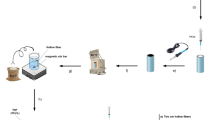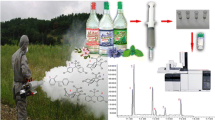Abstract
A novel solid/liquid phase microextraction (SLPME) technique was developed and applied to the simultaneous determination of five bisphenol-type endocrine disrupting chemicals (EDCs) including bisphenol A, bisphenol S, bisphenol F, bisphenol B and bisphenol AF. The method is based on the use of a graphene oxide nanoribbon-reinforced hollow fiber (GONRs-HF) and 1-octanol. GONRs were longitudinally unzipped from multiwalled carbon nanotubes (MWCNTs) by means of chemical oxidation and carefully characterized. GONRs were dispersed in ultrapure water with the assistance of surfactant and then immobilized into the wall pores of HF. Compared with CNTs, the hydrophilicity of GONRs was improved, and a uniform dispersion was formed. This simplifies the preparation process and reduces waste of materials. The pores and lumen of GONRs-HF were filled with 1-octanol, and then the whole assembly was used for the extraction of the analytes. In comparison with different extraction modes, GONRs-HF-SLPME exhibits a more effective extraction performance for five bisphenol-type EDCs. Response surface methodology was used to optimize experimental parameters affecting the extraction efficiency. The enrichment factors are in the range from 76 to 127 with good inter-fiber and batch-to-batch reproducibility. The method shows good linearity with determination coefficients (R2) higher than 0.9985. The limits of detection are in the range of 0.1–0.4 μg L−1. Recoveries from spiked real samples are between 83% and 114% with relative standard deviations between 1.6% and 7.8%.

Schematic presentation of the preparation of graphene oxide nanoribbons (GONRs) with multiwalled carbon nanotubes (MWCNTs), immobilization of GONRs into the pores of hollow fiber (HF), and application for solid/liquid phase microextraction (SLPME) of five bisphenol-type endocrine disrupting chemicals in three kinds of real samples.




Similar content being viewed by others
References
García-Córcoles MT, Cipa M, Rodríguez-Gómez R, Rivas A, Olea-Serrano F, Vílchez JL, Zafra-Gómez A (2018) Determination of bisphenols with estrogenic activity in plastic packaged baby food samples using solid-liquid extraction and clean-up with dispersive sorbents followed by gas chromatography tandem mass spectrometry analysis. Talanta 178:441–448
Liu L, Feng T, Wang C, Wu Q, Wang Z (2014) Magnetic three-dimensional graphene nanoparticles for the preconcentration of endocrine-disrupting phenols. Microchim Acta 181(11):1249–1255
Caballero-Casero N, Lunar L, Rubio S (2016) Analytical methods for the determination of mixtures of bisphenols and derivatives in human and environmental exposure sources and biological fluids. A review. Anal Chim Acta 908:22–53
Eladak S, Grisin T, Moison D, Guerquin MJ, N'Tumba-Byn T, Pozzi-Gaudin S, Benachi A, Livera G, Rouiller-Fabre V, Habert R (2015) A new chapter in the bisphenol a story: bisphenol S and bisphenol F are not safe alternatives to this compound. Fertil Steril 103(1):11–21
Song Y, Ma R, Jiao C, Hao L, Wang C, Wu Q, Wang Z (2017) Magnetic mesoporous polymelamine-formaldehyde resin as an adsorbent for endocrine disrupting chemicals. Microchim Acta 185(1):19
Wolff MS, Teitelbaum SL, McGovern K, Pinney SM, Windham GC, Galvez M, Pajak A, Rybak M, Calafat AM, Kushi LH, Biro FM, the Breast Cancer and Environment Research Program (2015) Environmental phenols and pubertal development in girls. Environ Int 84:174–180
Chen D, Kannan K, Tan H, Zheng Z, Feng YL, Wu Y, Widelka M (2016) Bisphenol analogues other than BPA: environmental occurrence, human exposure, and toxicity-a review. Environ Sci Technol 50(11):5438–5453
Cesen M, Lambropoulou D, Laimou-Geraniou M, Kosjek T, Blaznik U, Heath D, Heath E (2016) Determination of bisphenols and related compounds in honey and their migration from selected food contact m aterials. J Agric Food Chem 64(46):8866–8875
Qian L, Li X, Qi F, Li J, Lu L, Xu Q (2017) An amino-functionalized grooved nanofiber mat for solid-phase extraction of phenolic pollutants. Microchim Acta 184(8):2861–2870
Yang J, Li Y, Wang J, Sun X, Cao R, Sun H, Huang C, Chen J (2015) Molecularly imprinted polymer microspheres prepared by Pickering emulsion polymerization for selective solid-phase extraction of eight bisphenols from human urine samples. Anal Chim Acta 872:35–45
Yang D, Li X, Meng D, Wang M, Yang Y (2017) Supramolecular solvents combined with layered double hydroxide-coated magnetic nanoparticles for extraction of bisphenols and 4-tert-octylphenol from fruit juices. Food Chem 237:870–876
Xian Y, Wu Y, Dong H, Guo X, Wang B, Wang L (2017) Dispersive micro solid phase extraction (DMSPE) using polymer anion exchange (PAX) as the sorbent followed by UPLC-MS/MS for the rapid determination of four bisphenols in commercial edible oils. J Chromatogr A 1517:35–43
Corazza G, Merib J, Magosso HA, Bittencourt OR, Carasek E (2017) A hybrid material as a sorbent phase for the disposable pipette extraction technique enhances efficiency in the determination of phenolic endocrine-disrupting compounds. J Chromatogr A 1513:42–50
Kirschner N, Dias AN, Budziak D, da Silveira CB, Merib J, Carasek E (2017) Novel approach to high-throughput determination of endocrine disruptors using recycled diatomaceous earth as a green sorbent phase for thin-film solid-phase microextraction combined with 96-well plate system. Anal Chim Acta 996:29–37
Diao CP, Yang X, Sun AL, Liu RM (2015) Vortex-assisted liquid-liquid microextraction of bisphenol S prior to its determination by HPLC with UV detection. Microchim Acta 182(15):2593–2600
Perez RA, Albero B, Tadeo JL, Sanchez-Brunete C (2016) Determination of endocrine-disrupting compounds in water samples by magnetic nanoparticle-assisted dispersive liquid-liquid microextraction combined with gas chromatography-tandem mass spectrometry. Anal Bioanal Chem 408(28):8013–8023
Jiang YH, Zhang XL, Tang TT, Zhou TS, Shi GY (2015) Determination of endocrine disruptors in environmental water by single-drop microextraction and high-performance liquid chromatography. Anal Lett 48(4):710–725
Li J, Zhang HF, Shi YP (2011) Monitoring multi-class pesticide residues in fresh grape by hollow fiber sorptive extraction combined with gas chromatography-mass spectrometry. Food Chem 127(2):784–790
Song XY, Chen J, Shi YP (2015) Electromembrane extraction based on carbon nanotubes reinforced hollow fiber for the determination of plant hormones. New J Chem 39(12):9191–9199
Kazemi E, Haji Shabani AM, Dadfarnia S (2017) Application of graphene oxide-silica composite reinforced hollow fibers as a novel device for pseudo-stir bar solid phase microextraction of sulfadiazine in different matrices prior to its spectrophotometric determination. Food Chem 221:783–789
Es'haghi Z, Rezaeifar Z, Rounaghi GH, Nezhadi ZA, Golsefidi MA (2011) Synthesis and application of a novel solid-phase microextraction adsorbent: hollow fiber supported carbon nanotube reinforced sol-gel for determination of phenobarbital. Anal Chim Acta 689(1):122–128
Li J, Su Q, Li KY, Sun CF, Zhang WB (2013) Rapid analysis of phthalates in beverage and alcoholic samples by multi-walled carbon nanotubes/silica reinforced hollow fiber-solid phase microextraction. Food Chem 141(4):3714–3720
Fresco-Cala B, Jimenez-Soto JM, Cardenas S, Valcarcel M (2014) Single-walled carbon nanohorns immobilized on a microporous hollow polypropylene fiber as a sorbent for the extraction of volatile organic compounds from water samples. Microchim Acta 181(9):1117–1124
Matin AA, Biparva P, Gheshlaghi M (2014) Gas chromatographic determination of polycyclic aromatic hydrocarbons in water and smoked rice samples after solid-phase microextraction using multiwalled carbon nanotube loaded hollow fiber. J Chromatogr A 1374:50–57
Song XY, Shi YP, Chen J (2013) Carbon nanotubes-reinforced hollow fiber solid-phase microextraction coupled with high performance liquid chromatography for the determination of carbamate pesticides in apples. Food Chem 139(1–4):246–252
Song XY, Shi YP, Chen J (2013) Carbon nanotubes reinforced hollow fiber solid phase microextraction for the determination of strychnine and brucine in urine. Talanta 116:188–194
Ning JW, Zhang JJ, Pan YB, Guo JK (2004) Surfactants assisted processing of carbon nanotube-reinforced SiO2 matrix composites. Ceram Int 30(1):63–67
Loo S, Idapalapati S, Wang S, Shen L, Mhaisalkar SG (2007) Effect of surfactants on MWCNT-reinforced sol-gel silica dielectric composites. Scr Mater 57(12):1157–1160
Yang Y, Chen J, Shi YP (2012) Determination of diethylstilbestrol in milk using carbon nanotube-reinforced hollow fiber solid-phase microextraction combined with high-performance liquid chromatography. Talanta 97:222–228
Wang J, Cheng M, Zhang Z, Guo L, Liu Q, Jiang G (2015) An antibody-graphene oxide nanoribbon conjugate as a surface enhanced laser desorption/ionization probe with high sensitivity and selectivity. Chem Commun 51(22):4619–4622
Kosynkin DV, Higginbotham AL, Sinitskii A, Lomeda JR, Dimiev A, Price BK, Tour JM (2009) Longitudinal unzipping of carbon nanotubes to form graphene nanoribbons. Nature 458:872–876
Higginbotham AL, Kosynkin DV, Sinitskii A, Sun Z, Tour JM (2010) Lower-defect graphene oxide nanoribbons from multiwalled carbon nanotubes. ACS Nano 4(4):2059–2069
Xiang C, Cox PJ, Kukovecz A, Genorio B, Hashim DP, Yan Z, Peng Z, Hwang CC, Ruan G, Samuel ELG, Sudeep PM, Konya Z, Vajtai R, Ajayan PM, Tour JM (2013) Functionalized low defect graphene nanoribbons and polyurethane composite film for improved gas barrier and mechanical performances. ACS Nano 7(11):10380–10386
Liu Q, Cheng M, Wang J, Jiang G (2015) Graphene oxide nanoribbons: improved synthesis and application in MALDI mass spectrometry. Chem Eur J 21(14):5594–5599
Casado-Carmona FA, Alcudia-León MC, Lucena R, Cárdenas S, Valcárcel M (2016) Magnetic nanoparticles coated with ionic liquid for the extraction of endocrine disrupting compounds from waters. Microchem J 128:347–353
Acknowledgements
The work was supported by the National Nature Science Foundation of China (No. 21575150, 21775153 and 21822407), and the top priority program of “One-Three-Five” Strategic Planning of Lanzhou Institute of Chemical Physics, Chinese Academy of Sciences.
Author information
Authors and Affiliations
Corresponding authors
Ethics declarations
The author(s) declare that they have no competing interests.
Additional information
Publisher’s note
Springer Nature remains neutral with regard to jurisdictional claims in published maps and institutional affiliations.
Electronic supplementary material
ESM 1
(DOCX 1.69 mb)
Rights and permissions
About this article
Cite this article
Han, X., Chen, J., Qiu, H. et al. Solid/liquid phase microextraction of five bisphenol-type endocrine disrupting chemicals by using a hollow fiber reinforced with graphene oxide nanoribbons, and determination by HPLC-PDA. Microchim Acta 186, 375 (2019). https://doi.org/10.1007/s00604-019-3498-2
Received:
Accepted:
Published:
DOI: https://doi.org/10.1007/s00604-019-3498-2




